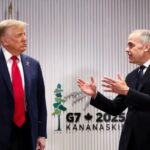Energy News Beat
New language: “In recent months, there has been a lack of further progress toward the Committee’s 2 percent inflation objective.”
By Wolf Richter for WOLF STREET.
The FOMC statement released today after its two-day meeting acknowledged for the first time that inflation resurfaced as an issue after a series of worrisome inflation reports so far this year have already killed Rate-Cut Mania. It added new language to that effect: “In recent months, there has been a lack of further progress toward the Committee’s 2 percent inflation objective.”
FOMC members voted unanimously today to maintain the Fed’s five policy rates, with the top of its policy rates at 5.50%, as had been broadly telegraphed all year with speeches, interviews, and panel discussions by Fed governors. The last rate hike occurred at its meeting in July 2023:
Federal funds rate target range between 5.25% and 5.5%.
Interest it pays the banks on reserves: 5.4%.
Interest it pays on overnight Reverse Repos (ON RRPs): 5.3%.
Interest it charges on overnight Repos: 5.5%.
Primary credit rate: 5.5% (banks’ costs to borrow at the “Discount Window”).
Push-back on Rate-Cut Mania: Back at the January meeting, the Fed had added new language to its statement to push back against Rate-Cut Mania. At today’s meeting, it repeated that language for the third time:
“In considering any adjustments to the target range for the federal funds rate, the Committee will carefully assess incoming data, the evolving outlook, and the balance of risks.”
“The Committee does not expect it will be appropriate to reduce the target range until it has gained greater confidence that inflation is moving sustainably toward 2 percent.”
QT slow-down starts in June: The Fed has been discussing for months in vague bits and pieces its future plans to slow down QT, on the theory, as Powell had put it at the last press conference, that “by going slower, you can get farther,” to avoid the kind of blowup they got in the repo market in 2019 which the Fed linked to QT-1. The Fed has already shed over $1.5 trillion in assets since it started QT in July 2022.
Today it said that QT will continue at its current pace through May but will slow beginning in June:
The cap for the Treasury roll-off will be reduced from $60 billion to $25 billion
The cap for the MBS roll-off will remain unchanged at $35 billion.
If MBS roll-off excess of the $35 billion cap, the overage will be replaced with Treasury securities, and not MBS.
And it repeated: “The Committee is strongly committed to returning inflation to its 2 percent objective.”
It replaced the old language on the labor market:
“The Committee judges that the risks to achieving its employment and inflation goals are moving into better balance.”
With:
“The Committee judges that the risks to achieving its employment and inflation goals have moved toward better balance over the past year.”
Powell will likely use the press conference to provide more details as to when the slowdown might start and what it might look like.
It was a no-dot-plot meeting. Today’s meeting was one of the four meetings a year when the Fed does not release a “Summary of Economic Projections” (SEP), which includes the infamous “dot plot” which shows how each FOMC member sees the development of future policy rates. SEP releases occur quarterly at meetings that are near the end of the quarter. The next SEP will be released after the June 11-12 meeting.
Powell at the press conference on rate hikes, no rate cuts, rate cuts, and the QT slowdown while getting rid of MBS entirely: Oh Deary, Where Did my Rate Cuts Go? Fed’s Wait-and-See Now Entrenched? And Suddenly Lots of Talk about “Rate Hikes”
Here is the whole statement:
Recent indicators suggest that economic activity has continued to expand at a solid pace. Job gains have remained strong, and the unemployment rate has remained low. Inflation has eased over the past year but remains elevated. In recent months, there has been a lack of further progress toward the Committee’s 2 percent inflation objective.
The Committee seeks to achieve maximum employment and inflation at the rate of 2 percent over the longer run. The Committee judges that the risks to achieving its employment and inflation goals have moved toward better balance over the past year. The economic outlook is uncertain, and the Committee remains highly attentive to inflation risks.
In support of its goals, the Committee decided to maintain the target range for the federal funds rate at 5-1/4 to 5-1/2 percent. In considering any adjustments to the target range for the federal funds rate, the Committee will carefully assess incoming data, the evolving outlook, and the balance of risks. The Committee does not expect it will be appropriate to reduce the target range until it has gained greater confidence that inflation is moving sustainably toward 2 percent. In addition, the Committee will continue reducing its holdings of Treasury securities and agency debt and agency mortgage‑backed securities. Beginning in June, the Committee will slow the pace of decline of its securities holdings by reducing the monthly redemption cap on Treasury securities from $60 billion to $25 billion. The Committee will maintain the monthly redemption cap on agency debt and agency mortgage‑backed securities at $35 billion and will reinvest any principal payments in excess of this cap into Treasury securities. The Committee is strongly committed to returning inflation to its 2 percent objective.
In assessing the appropriate stance of monetary policy, the Committee will continue to monitor the implications of incoming information for the economic outlook. The Committee would be prepared to adjust the stance of monetary policy as appropriate if risks emerge that could impede the attainment of the Committee’s goals. The Committee’s assessments will take into account a wide range of information, including readings on labor market conditions, inflation pressures and inflation expectations, and financial and international developments.
Voting for the monetary policy action were Jerome H. Powell, Chair; John C. Williams, Vice Chair; Thomas I. Barkin; Michael S. Barr; Raphael W. Bostic; Michelle W. Bowman; Lisa D. Cook; Mary C. Daly; Philip N. Jefferson; Adriana D. Kugler; Loretta J. Mester; and Christopher J. Waller.
Enjoy reading WOLF STREET and want to support it? You can donate. I appreciate it immensely. Click on the beer and iced-tea mug to find out how:
Would you like to be notified via email when WOLF STREET publishes a new article? Sign up here.
The post Fed Holds Rates at 5.50% Top of Range, QT Slowdown Starts in June, Acknowledged Inflation is a Problem Again appeared first on Energy News Beat.








